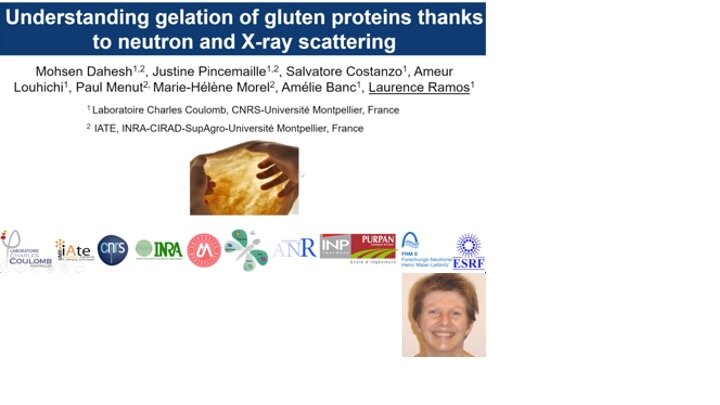VIDEO - Northern Lights on Food II workshop - Understanding gelation of gluten proteins thanks to neutron and X-ray scattering with Laurence Ramos


VIDEO - Northern Lights on Food II workshop - Understanding gelation of gluten proteins thanks to neutron and X-ray scattering with Laurence Ramos
Speaker: Laurence Ramos, CNRS-University Montpellier, France
This lecture was part of the workshop, Northern Lights on Food II, organised on June 9-11, 2021, by the LINXS working group Food, with support from Formas.
Abstract
The origin of the unique rheological properties of wheat gluten, the water-insoluble protein fraction of wheat grain, is crucial in bread-making processes and questions scientists since the 18th century. Gluten is a complex mixture of two families of proteins, monomeric gliadins (Gli) and polymeric glutenins (Glu). To better understand the respective role of the different classes of proteins in the supramolecular structure of gluten and its link to the material properties, we have developed model gluten systems comprising controlled amounts of Gli and Glu in food-grade binary solvents [1]. Using contrast variation techniques and small-angle neutron scattering, we have evidenced in gluten gels the presence of distinct regions of typical size several tens of nm, which arise from the preferential interaction of Glu polymers through a tight network of non-exchangeable intermolecular hydrogen bonds, at the origin of the gelation of gluten [3]. In addition, we have used time-resolved synchrotron ultra-small X-ray scattering to quantitatively probe the dynamics of liquid-liquid phase separation (LLPS) in gluten protein suspensions following a temperature quench [4]. Fluid viscoelastic samples depleted in polymer Glu phase separate following a spinodal decomposition process, with a coarsening resulting from a competition between thermodynamics and transport. Anomalous phase-separation dynamics is by contrast measured for gluten gels rich in Glu, due to elastic constraints, illustrating the role of viscoelasticity in the dynamics of LLPS in protein dispersions. Additional experiments conducted by changing the solvent, from pure water (a bad solvent for gluten proteins) to ethanol/water (60/40 v/v) (a good solvent for gluten proteins) confirm the subtle interplay between phase-separation and viscoelasticity in gluten proteins gels [5].
[1] Dahesh et al. Polymeric assembly of gluten proteins in an aqueous ethanol solvent. J Phys Chem B 118, 11065 (2014).
[2] Banc et al. Small angle neutron scattering contrast variation reveals heterogeneities of interactions in protein gels. Soft Matter 12, 5340 (2016).
[3] Dahesh et al. Spontaneous gelation of wheat gluten proteins in a food grade solvent. Food Hydrocolloids, 52, 1 (2016).
[4] Banc et al. Phase separation dynamics of gluten protein mixtures. Soft Matter 15, 6160 (2019).
[5] Costanzo et al. Tailoring the viscoelasticity of polymer gels of gluten proteins through solvent quality. Submitted (2020)
